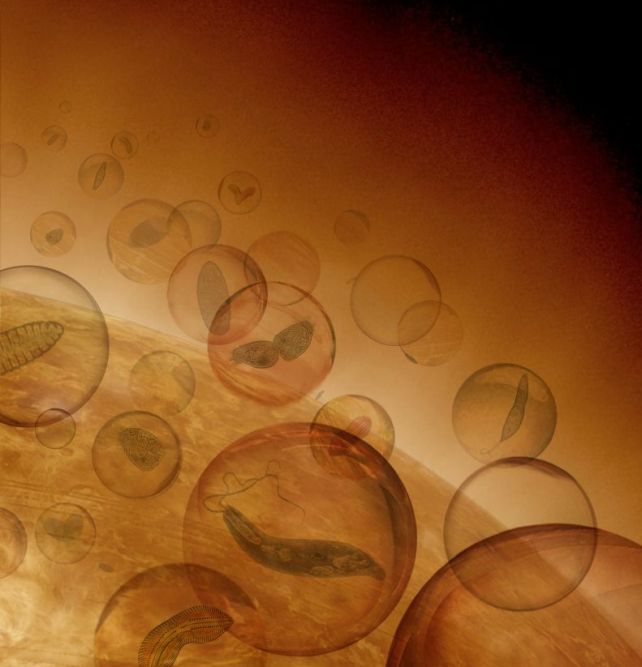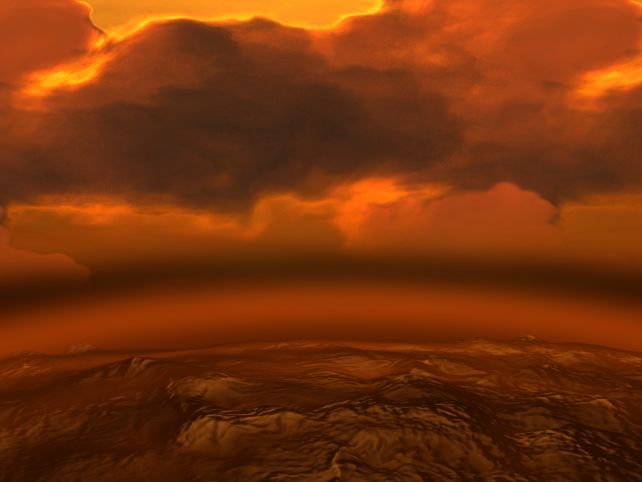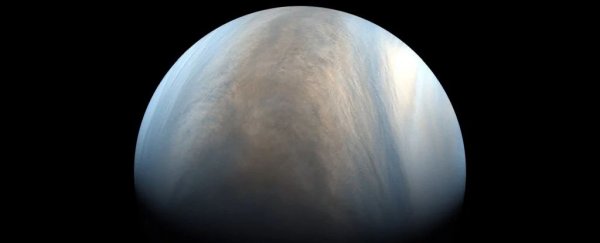Venus, but for some quirk of planetary evolution, could have been Earth or vice versa.
The two planets share many similarities, but where Earth is moist and temperate, Venus has a scorching hot surface shrouded with a thick atmosphere of toxic and acidic fumes.
Nevertheless, that atmosphere is not entirely inhospitable, according to new research. Although the chance microbes might thrive in such an environment is slim, it's plausible enough to warrant considering.
"The clouds can support a biomass that could readily be detectable by future astrobiology-focused space missions from its impact on the atmosphere," write a team led by molecular biologist William Bains of Cardiff University in the UK and MIT in the US in a paper published in Astrobiology.
"Although we consider the prospects for finding life on Venus to be speculative, they are not absent. The scientific reward from finding life in such an un-Earthlike environment justifies considering how observations and missions should be designed to be capable of detecting life if it is there."
The prospect of life on Venus has loomed large in the collective imagination of Earth since the discovery of traces of phosphine gas in the planet's atmosphere in 2020.
Phosphine can be produced by biological and geological processes, and its detection has been hotly debated. The debate did ignite a keen scientific interest in re-examining our presuppositions about Venus's habitability, or lack thereof.
The surface itself is unlikely to be habitable to life as we know it: Temperatures on the Venusian ground average around 464 degrees Celsius (867 Fahrenheit). Life's chemistry requires a solvent (here on Earth, that's water), and those temperatures are incompatible with any liquid. But Venus's skies, although much more temperate, are laced with clouds of sulfuric acid and were not thought to be much better.

Bains is a member of a team led by astronomer Sara Seager and including biochemist Janusz Petkowski, both of MIT, investigating the possibility of life in the Venusian atmosphere.
This team just released two new papers. A paper in PNAS by a larger group led by Seager experimentally explores whether key molecules for life can survive in sulfuric acid; the Astrobiology paper mentioned above examines and addresses the arguments against Venusian habitability.
Let's talk about sulfuric acid first. Previous research from the team found that sulfuric acid could be used by life as a solvent, but it wouldn't be life as we know it. One major reason for that is that RNA and DNA are unstable in sulfuric acid. But nucleic bases – the basic building blocks of RNA and DNA – might not be, depending on what they are.
To test whether nucleic bases can remain stable in sulfuric acid, the researchers… well, put a bunch of nucleic bases in sulfuric acid of concentrations between 81 and 98 percent, with the remainder being water.
Adenine, cytosine, guanine, thymine, and uracil remained stable for several weeks at room temperature, between 18 and 21 degrees Celsius, similar to Venusian cloud temperatures.
So did purine and pyrimidine, as well as a compound called 2,6-diaminopurine, which is used as a genetic base substitute for adenine by some viruses. This means that, theoretically, at least, the same nucleic bases could hang around quite happily in the sulfuric acid clouds of Venus.

"Our findings show that complex organic chemistry, including DNA nucleic acid bases, can be stable in concentrated sulfuric acid and motivates us to design missions that directly probe the cloud particles for the presence of organic material," they write.
In the second paper, the team breaks down arguments against the possibility of life, focusing heavily on whether the features of Venus's clouds and atmosphere make the prospect of life vanishingly improbable.
The lack of water is a big hurdle since life on Earth relies upon it. This is what the research into sulfuric acid addresses, and the researchers found that it's not impossible that sulfuric acid takes up the role water plays here on Earth.
Another hurdle is gravity; any mass, however small, would have difficulty remaining aloft against the downward pressure gravity exerts. In this case, the team found that gravity waves – just waves in the atmosphere; we have them here on Earth – could keep a large enough population of microbes aloft to maintain a stable biosphere. Alternatively, an effect called negative photophoresis could use the heat generated by light to provide lift.

Although there's not sufficient chemical energy in the Venusian atmosphere to sustain life, there is a lot of life. Enough, according to the team's calculations, to grow and maintain a biomass in the manner of photosynthesis or phototrophy. Nor did the team find the lack of hydrogen or metals on Venus enough of a barrier to completely rule out the possibility of life.
That life is worth looking for, assert the researchers. If it is there, it's unlikely to be like anything we have living here on Earth and learning about it could significantly enhance our understanding of the variety of ways life could emerge in our Universe.
"While life on Venus remains speculative, and although the majority of the community believe that there is only a small chance that there is life in the clouds of Venus, none of the arguments rule out the possibility of life there," they write.
"Terrestrial life cannot survive in Venus' clouds. We encourage others to consider Venus as a place where some highly non-terrestrial life just might live and to explore what that life might be and how we might economically search for it."
The papers are both open-access, and they're worth a read. They can be found on PNAS and Astrobiology.
